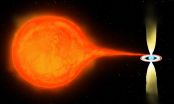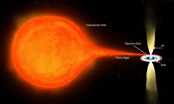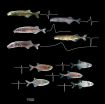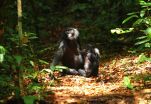(Press-News.org) A super-dense star formed in the aftermath of a supernova explosion is shooting out powerful jets of material into space, research suggests.
In a study published today, a team of scientists in the Australia and the Netherlands has discovered powerful jets blasting out of a double star system known as PSR J1023+0038.
It was previously thought that the only objects in the Universe capable of forming such powerful jets were black holes.
PSR J1023+0038 contains an extremely dense type of star astronomers call a neutron star, in a close orbit with another, more normal star nearby.
It was first identified as a neutron star in 2009 but it was only when the research team observed the star with the Very Large Array radio telescope in the United States in 2013 and 2014 that they realised the star was producing much stronger jets than expected.
Astronomer James Miller-Jones, from the Curtin University node of the International Centre for Radio Astronomy Research (ICRAR), says neutron stars can be thought of as stellar corpses.
"They're formed when a massive star runs out of fuel and undergoes a supernova, and the central parts of the star collapse under their own gravity," he says.
"These things are typically about one and a half times the mass of the Sun and yet they're only 10-15km across, so they're incredibly dense."
ASTRON astronomer Adam Deller, who led the research, says neutron stars and black holes are sometimes found in orbit with a nearby "companion" star.
"Gas can then flow from the companion star to the neutron star or black hole, producing spectacular displays when some of the material is blasted out in powerful jets at close to the speed of light," he says.
"From what we had seen previously, black holes were previously considered the undisputed kings of forming powerful jets, even when they were only fed by a little bit of material from their companion star."
"In comparison, neutron stars seemed to make relatively puny jets, which only became bright enough to see when the neutron stars were gobbling gas from their companions at a very high rate."
Dr Deller says when the team looked at PSR J1023+0038 it was only consuming a trickle of material and should have been producing a very feeble jet.
"But our observations suggest its jets are nearly as strong as you'd expect from a black hole," he says.
Dr Miller-Jones says PSR J1023+0038 is a "transitional" neutron star, spending years at a time powered mainly by the rotation of the neutron star but transitioning occasionally into an active gathering state, when it gets much brighter.
"Two other transitional systems are now known and both of these have also been shown to exhibit powerful jets," he says.
"This is casting neutron stars in a new light and showing that in fact they can sometimes launch jets to rival those coming from black holes."
The research was published today in the Astrophysical Journal.
INFORMATION:
More Information:
ICRAR is a joint venture between Curtin University and The University of Western Australia with support and funding from the State Government of Western Australia.
Original publication details:
'Radio Imaging Observations of PSR J1023+0038 in an LMXB State' published in the Astrophysical Journal on 4/8/2015. Available online at http://arxiv.org/pdf/1412.5155.pdf
Supporting Multimedia:
Images are available at high resolution from: http://www.icrar.org/superstar
Contact Details:
Dr James Miller-Jones (ICRAR/Curtin University)
Ph: +61 8 9266 9141 E: james.miller-jones@icrar.org M: +61 488 484 825
Dr Adam Deller (ASTRON)
Ph: +31 610 906 427 E: deller@astron.nl
Pete Wheeler (Media Contact, ICRAR)
Ph: +61 8 6488 7758 E: pete.wheeler@icrar.org M: +61 423 982 018
Flight simulators for the training of air pilots are well known. But what about riding simulators? Although the first horse simulator was used at the French National Equestrian School in Saumur already in the 1980s, riding simulators for dressage, show jumping, polo or racing, have become available only recently. They look like horses and respond to the aids of the rider via sensors which measure the force exerted by the reins and the rider's legs. Via a screen in front of the simulator, the rider immerses himself into a virtual equestrian world.
Simulators are aimed ...
Scientists first had to re-think death before they could develop a way of testing the potential harm to the environment caused by thousands of chemicals humankind uses each day.
Researchers led by Dr Roman Ashauer, of the Environment Department at the University of York, refined the technique of survival analysis used routinely by toxicologists, biologists, medical researchers and engineers. The research could pave the way for testing the estimated 15,000 substances discovered daily.
Survival analysis which helps to predict a huge range of functions such as the survival ...
New research by scientists at New Zealand's University of Otago and GNS Science is helping to solve the puzzle of how bacteria are able to live in nutrient-starved environments. It is well-established that the majority of bacteria in soil ecosystems live in dormant states due to nutrient deprivation, but the metabolic strategies that enable their survival have not yet been shown.
The researchers took an extreme approach to resolving this enigma.
They studied a strain of acidobacteria named Pyrinomonas methylaliphatogenes that was cultivated from heated and acidic geothermal ...
A study including researchers from the U.S. Department of Energy's Argonne National Laboratory and the University of Chicago found evidence that gut microbes affect circadian rhythms and metabolism in mice.
We know from studies on jet lag and night shifts that metabolism--how bodies use energy from food--is linked to the body's circadian rhythms. These rhythms, regular daily fluctuations in mental and bodily functions, are communicated and carried out via signals sent from the brain and liver. Light and dark signals guide circadian rhythms, but it appears that microbes ...
The more than 200 species in the family Mormyridae communicate with one another in a way completely alien to our species: by means of electric discharges generated by an organ in their tails.
In a 2011 article in Science that described a group of mormyrids able to perceive subtle variations in the waveform of electric signals, Washington University in St. Louis biologist Bruce Carlson, PhD, noted that another group of mormyrids are much less discriminating (see illustration).
The fish with nuanced signal discrimination can glean a stunning amount of information from ...
Cleaning up municipal and industrial wastewater can be dirty business, but engineers at the University of Colorado Boulder have developed an innovative wastewater treatment process that not only mitigates carbon dioxide (CO2) emissions, but actively captures greenhouse gases as well.
The treatment method, known as Microbial Electrolytic Carbon Capture (MECC), purifies wastewater in an environmentally-friendly fashion by using an electrochemical reaction that absorbs more CO2 than it releases while creating renewable energy in the process.
"This energy-positive, carbon-negative ...
(BOSTON) - Super productive factories of the future could employ fleets of genetically engineered bacterial cells, such as common E. coli, to produce valuable chemical commodities in an environmentally friendly way. By leveraging their natural metabolic processes, bacteria could be re-programmed to convert readily available sources of natural energy into pharmaceuticals, plastics and fuel products.
"The basic idea is that we want to accelerate evolution to make awesome amounts of valuable chemicals," said Wyss Core Faculty member George Church, Ph.D., who is a pioneer ...
Some neutron stars may rival black holes in their ability to accelerate powerful jets of material to nearly the speed of light, astronomers using the Karl G. Jansky Very Large Array (VLA) have discovered.
"It's surprising, and it tells us that something we hadn't previously suspected must be going on in some systems that include a neutron star and a more-normal companion star," said Adam Deller, of ASTRON, the Netherlands Institute for Radio Astronomy.
Black holes and neutron stars are respectively the densest and second most dense forms of matter known in the Universe. ...
From an early age, human infants are able to produce vocalisations in a wide range of emotional states and situations - an ability felt to be one of the factors required for the development of language. Researchers have found that wild bonobos (our closest living relatives) are able to vocalize in a similar manner. Their findings challenge how we think about the evolution of communication and potentially move the dividing line between humans and other apes.
Animal vocalisations are usually made in relatively narrow behavioural contexts linked to emotional states, such ...
Washington, DC-- Climate change caused by greenhouse gas emissions will alter the way that Americans heat and cool their homes. By the end of this century, the number of days each year that heating and air conditioning are used will decrease in the Northern states, as winters get warmer, and increase in Southern states, as summers get hotter, according to a new study from a high school student, Yana Petri, working with Carnegie's Ken Caldeira. It is published by Scientific Reports.
"Changes in outdoor temperatures have a substantial impact on energy use inside," Caldeira ...




